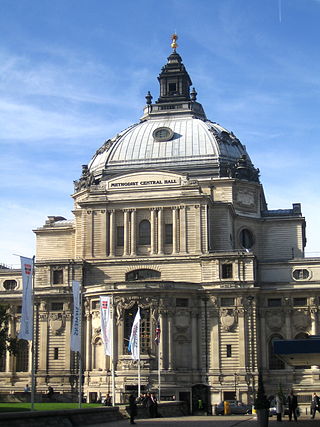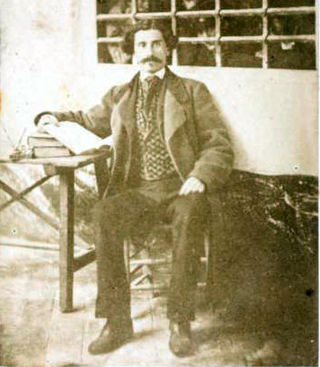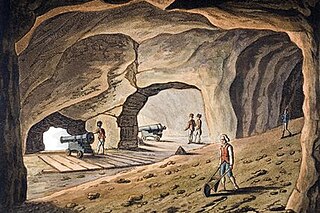Methodism, also called the Methodist movement, is a group of historically related denominations of Protestant Christianity whose origins, doctrine and practice derive from the life and teachings of John Wesley. George Whitefield and John's brother Charles Wesley were also significant early leaders in the movement. They were named Methodists for "the methodical way in which they carried out their Christian faith". Methodism originated as a revival movement within Anglicanism originating out of the Church of England in the 18th century and became a separate denomination after Wesley's death. The movement spread throughout the British Empire, the United States, and beyond because of vigorous missionary work, and today has about 80 million adherents worldwide.
The Methodist Episcopal Church (MEC) was the oldest and largest Methodist denomination in the United States from its founding in 1784 until 1939. It was also the first religious denomination in the US to organize itself nationally. In 1939, the MEC reunited with two breakaway Methodist denominations to form the Methodist Church. In 1968, the Methodist Church merged with the Evangelical United Brethren Church to form the United Methodist Church.
The Methodist Episcopal Church, South was the American Methodist denomination resulting from the 19th-century split over the issue of slavery in the Methodist Episcopal Church (MEC). Disagreement on this issue had been increasing in strength for decades between churches of the Northern and Southern United States; in 1845 it resulted in a schism at the General Conference of the MEC held in Louisville, Kentucky.
The Primitive Methodist Church is a Methodist Christian denomination within the holiness movement. It began in England in the early 19th century, with the influence of American evangelist Lorenzo Dow (1777–1834).

The Presbyterian Church of Wales, also known as the Calvinistic Methodist Church, is a denomination of Protestant Christianity in Wales.
The Methodist Church of Great Britain is a Protestant Christian denomination in Britain, and the mother church to Methodists worldwide. It participates in the World Methodist Council, and the World Council of Churches among other ecumenical associations.
A missionary bishop is one assigned in the Anglican Communion to an area that is not already organized under a bishop of a church. The term was also used in the Methodist churches at one time, but this was discontinued in 1964.

Thomas Coke was the first Methodist bishop. Born in Brecon, Wales, he was ordained as a priest in 1772, but expelled from his Anglican pulpit of South Petherton for being a Methodist. Coke met John Wesley in 1776. He later co-founded Methodism in America and then established the Methodist missions overseas, which in the 19th century spread around the world.

The Methodist Church Ghana is one of the largest and oldest mainline Protestant denominations in Ghana. It traces its roots back to the landing of the Rev. Joseph Dunwell on 1 January 1835 in Cape Coast, in the Gold Coast. The Rev. T. B. Freeman, another missionary, took the Christian message beyond Cape Coast to the Ashanti Empire, to Nigeria, and to other parts of the region to become the father of Methodism in West Africa.
The Evangelical Church of North America (ECNA) is a Wesleyan-Holiness, Protestant Christian denomination headquartered in Clackamas, Oregon. As of 2000, the Church had 12,475 members in 133 local churches. The Church sponsors missionaries in seven countries.

St. George's United Methodist Church, located at the corner of 4th and New Streets, in the Old City neighborhood of Philadelphia, is the oldest Methodist church in continuous use in the United States, beginning in 1769. The congregation was founded in 1767, meeting initially in a sail loft on Dock Street, and in 1769 it purchased the shell of a building which had been erected in 1763 by a German Reformed congregation. At this time, Methodists had not yet broken away from the Anglican Church and the Methodist Episcopal Church was not founded until 1784.
Superintendent is the title given to a person who is a leader of a Christian denomination at the regional or national level in some Protestant denominations.

Education in Gibraltar generally follows the English system operating within a three tier system. Schools in Gibraltar follow the Key Stage system which teaches the National Curriculum.

The organisation of the Methodist Church of Great Britain is based on the principle of connexionalism. This means that British Methodism, from its inception under John Wesley (1703–1791), has always laid strong emphasis on mutual support, in terms of ministry, mission and finance, of one local congregation for another. No singular church community has ever been seen in isolation either from its immediately neighbouring church communities or from the centralised national organisation. Wesley himself journeyed around the country, preaching and establishing local worshipping communities, called "societies", often under lay leadership. Soon these local communities of worshipping Christians formalised their relationships with neighbouring Methodist communities to create "circuits", and the circuits and societies contained within them, were from the very beginning 'connected' to the centre and Methodism's governing body, the annual Conference. Today, societies are better known as local churches, although the concept of a community of worshipping Christians tied to a particular location, and subdivided into smaller cell groups called "classes", remains essentially based on Wesley's societies.
Methodist views on the ordination of women in the rite of holy orders are diverse.

Manuel Matamoros García (1834–1866) was a leading Spanish Protestant.

The history of Methodism in the United States dates back to the mid-18th century with the ministries of early Methodist preachers such as Laurence Coughlan and Robert Strawbridge. Following the American Revolution most of the Anglican clergy who had been in America came back to England. John Wesley, the founder of Methodism, sent Thomas Coke to America where he and Francis Asbury founded the Methodist Episcopal Church, which was to later establish itself as the largest denomination in America during the 19th century.

Henry Ince (1736–1808) was a sergeant-major in the British Army who achieved fame as the author of a plan to tunnel through the North Face of the Rock of Gibraltar in 1782, during the Great Siege of Gibraltar. As a result of his work, by the end of the 18th century Gibraltar had almost 4,000 feet (1,200 m) of tunnels in which dozens of cannons were mounted overlooking the isthmus linking the peninsula to Spain. He was one of the first members of the Soldier Artificer Company, a predecessor to today's Royal Engineers, and rose to be the company's senior non-commissioned officer. He was also a founder of Methodism in Gibraltar through his activities as a Methodist lay preacher. Ince spent most of his life in the Army and served for 36 years in Gibraltar before retiring to Devon four years before he died at the age of 72.

William Harris Rule was a British Methodist missionary and writer. Rule and his wife started schools building to 400 pupils in Gibraltar. He tried to establish missions in Spain.
The history of Methodism in Sichuan began in the late 19th century when missionaries began to arrive from the United States. Methodists founded or helped found several colleges, schools, and hospitals to aid in modernization and conversion efforts. Later, American Methodists were joined by missionaries from Canada. Methodism grew to become one of the two largest denominations of Protestant Christianity in the province by 1922, along with Anglicanism.










